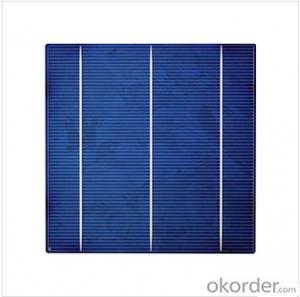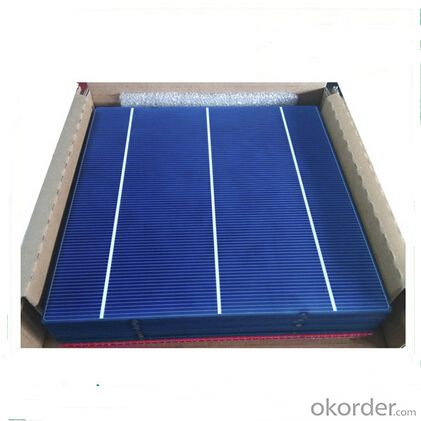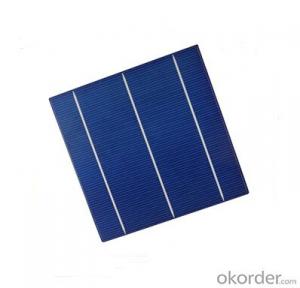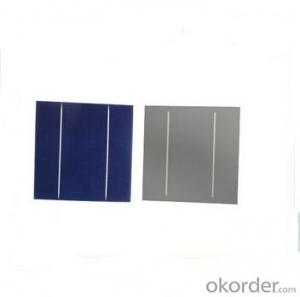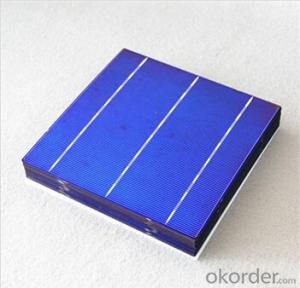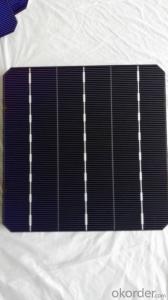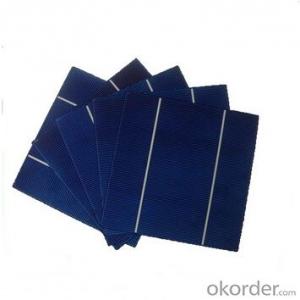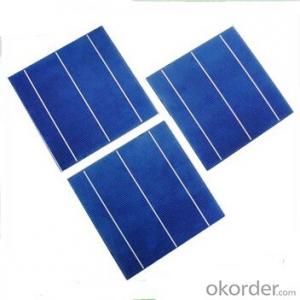Excitonic Polycrystalline Solar Cells Series- 16.0-17.2 -156x156mm ±0.5mm
- Loading Port:
- Shanghai
- Payment Terms:
- TT OR LC
- Min Order Qty:
- 3000 pc
- Supply Capability:
- 300000 pc/month
OKorder Service Pledge
OKorder Financial Service
You Might Also Like
Solar Cells:
Solar cells is made by solar wafer, it has three categories of solar cell right now, monocrystalline polycrystalline and thin film,These cells are entirely based around the concept PN junction, which is the critical part of solar module, it is the part that can convert the light energy into electricity, the thickness is from 180um to 200um, with even busbars to conduct electricity, textured cell can decrease diffuse reflection; they are often electrically connected and encapsulated as a module. Photovoltaic modules often have a sheet of glass on the front (sun up) side, allowing light to pass while protecting semiconductor wafers from abrasion and impact due to wind-driven debris, rain, hail, etc. Solar cells are also usually connected in series in modules, creating an additive voltage. Connecting cells in parallel will yield a higher current;With high quality and stable quality. Our Cells can greatly improve the performance of Solar Modules.
Features:
1. High conversion efficiencies resulting in superior power output performance.
2. Proven long term mechanical stability of silicon
3. Make of highly purified poly silicon
4. Three bus bars for reduced series resistance and improved module and cell efficiency
5. Blue anti-reflecting coating ensures improved light absorption and increased efficiency
6. Acid texturization offers a uniform appearance and virtually invisible crystal structure
7. Excellent low light behavior for improved energy yield
Solar Cells Advantage:
• High efficiency and stable performance in photovoltaic conversion.
• Advanced diffusion technique ensuring the homogeneity of energy conversion efficiency of the cell.
• Advanced PECVD film forming, providing a dark blue silicon nitride anti-reflection film of homogenous color and attractive appearance.
• High quality metal paste for back surface and electrode, ensuring good conductivity, high pulling strength and ease of soldering.
• High precision patterning using screen printing, ensuring accurate busbar location for ease with automatic soldering a laser cutting.
Specifications:
Format | 156x156mm ±0.5mm |
Diameter | 220±0.5mm |
Thickness | 200±20um |
Weight | 12±0.5g |
Front(-) | 1.8mm bus bars (Silver) |
Blue anti-reflecting coating (Silicon nitride) | |
Back (+) | 3mm wide soldering pads (Silver) |
Back surface field (aluminum). |
Efficiency cell (%) | Maximum power Pmpp(w) | Peak voltage Vmp(V) | Peak current Imp (A) | Open-circuit Voltage Voc(V) | Short-circuit current Isc(A) |
17.0-17.2 | 4.14 | 0.523 | 7.957 | 0.628 | 8.454 |
16.8-17.0 | 4.09 | 0.520 | 7.883 | 0.627 | 8.362 |
16.6-16.8 | 4.04 | 0.518 | 7.832 | 0.626 | 8.315 |
16.4-16.6 | 3.99 | 0.516 | 7.779 | 0.623 | 8.265 |
16.2-16.4 | 3.94 | 0.514 | 7.772 | 0.620 | 8.210 |
16.0-16.2 | 3.89 | 0.511 | 7.668 | 0.618 | 8.158 |
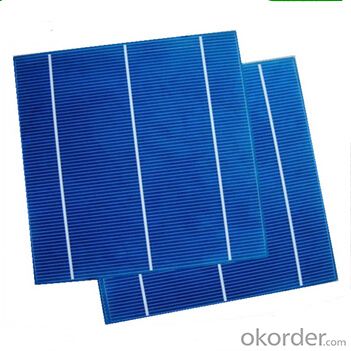
FAQ
We have organized several common questions for our clients,may help you sincerely:
①What price for each watt?
It depends on the efficiency of the solar cell, quantity, delivery date and payment terms.
②How long can we receive the product after purchase?
In the purchase of product within three working days, We will arrange the factory delivery as soon as possible. The pecific time of receiving is related to the state and position of customers.Commonly 7 to 10 working days can be served.
③Can you provide the peripheral products of the solar panels, such as the battery, controller, and inverter? If so, can you tell me how do they match each other?
Yes, we can, we have two companies for solar region, one is CNBM International, the other is CNBM engineering Co.
We can provide you not only the solar module but also the off grid solar system, we can also provide you service with on grid plant.
④What is your warranty of solar cell?
Our product can promise lower than 0.3% open box crack, we support claim after opening the box if it has crackm color difference or sth, the buyer should give pictures immediately, we can not accept the claim after the solar cell has assembled to solar panel.
• Timeliness of delivery
• ⑤How do you pack your products?
We have rich experience on how to pack the solar cell to make sure the safety on shipment, we could use wooden box or pallet as buyer's preference.
- Q: How do solar cells perform in areas with high levels of vibration?
- Solar cells generally perform well in areas with high levels of vibration. The cells are designed to be sturdy and resistant to vibrations, ensuring their longevity and efficiency. However, it is essential to ensure proper installation and maintenance to minimize any potential damage or displacement caused by excessive vibrations.
- Q: What is a High-efficiency electric solar cell panel?
- None of the electric solar cell panel that I bought in the market is really highly efficient because there have been always some quality problems or defects.
- Q: How do solar cells perform in areas with high levels of electromagnetic interference?
- Solar cells can be affected by high levels of electromagnetic interference (EMI), which can lead to reduced performance. EMI, such as radio frequency interference or electromagnetic radiation from nearby electronic devices, can disrupt the proper functioning of solar cells by interfering with their ability to convert sunlight into electricity. Therefore, in areas with high EMI levels, solar cells may experience decreased efficiency and output. Implementing shielding techniques and using quality components can help mitigate the impact of EMI on solar cell performance.
- Q: Can solar cells be used to power remote transportation systems?
- Yes, solar cells can be used to power remote transportation systems. Solar cells are a reliable and sustainable source of renewable energy that can be installed on vehicles or infrastructure to provide power for electric motors, batteries, or other components. This allows remote transportation systems such as electric cars, boats, or drones to operate efficiently without relying on fossil fuels or traditional power grids, making them more environmentally friendly and cost-effective in remote areas.
- Q: How do solar cells perform in different geographical locations?
- Solar cells perform differently in different geographical locations due to variations in sunlight intensity and weather conditions. Generally, locations closer to the equator receive more sunlight and have higher solar energy potential, resulting in better solar cell performance. However, solar cells can still generate electricity in less sunny areas, albeit with reduced efficiency. Factors such as cloud cover, temperature, and air pollution can also affect their performance. Therefore, it is important to consider the specific geographical location and its unique characteristics when assessing the performance of solar cells.
- Q: What is the pollution of solar cells?
- Now we know the battery is mainly solar cells, chemical batteries, thermocouple batteries, fuel cells, atomic batteries, chemical batteries can be divided into V batteries, batteries, batteries, alkaline batteries, micro batteries, we are common The main battery,
- Q: Can solar cells work in cloudy weather?
- Yes, solar cells can still generate electricity in cloudy weather, although their efficiency may be reduced. Cloud cover reduces the amount of direct sunlight reaching the solar panels, resulting in lower power output compared to sunny conditions. However, modern solar technologies, such as thin-film solar cells, are capable of generating electricity even in low-light conditions, making them suitable for use in areas with frequent cloud cover.
- Q: What is the maximum efficiency of a solar cell?
- The maximum efficiency of a solar cell refers to the highest percentage of sunlight that can be converted into electricity, which is currently around 46%.
- Q: How can I understand the working principles of solar cells?
- Read as many books as you can.
- Q: Can solar cells be installed on vehicles?
- Yes, solar cells can be installed on vehicles. In fact, many electric and hybrid vehicles are equipped with solar panels on their roofs or hoods to harness solar energy and supplement their power source. These solar cells help to charge the vehicle's battery and increase its overall efficiency, reducing the reliance on traditional charging methods and improving sustainability.
Send your message to us
Excitonic Polycrystalline Solar Cells Series- 16.0-17.2 -156x156mm ±0.5mm
- Loading Port:
- Shanghai
- Payment Terms:
- TT OR LC
- Min Order Qty:
- 3000 pc
- Supply Capability:
- 300000 pc/month
OKorder Service Pledge
OKorder Financial Service
Similar products
Hot products
Hot Searches
Related keywords
